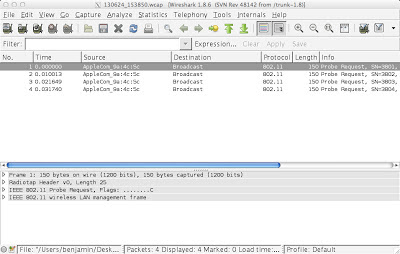iPhone 5 Probes the Right Way, Too
Quiet when standing still; active when moving. That is the way that WiFi devices should treat Probe Requests. Android devices (at least, Android devices that act like yours truly's Samsung Galaxy Tab 2) probe the right way. After doing a quick test on the iPhone 5, it appears that Apple has their devices probe based on movement as well.
Apple iOS devices have a terrible reputation in some WiFi circles. The author has heard complaints about mobility, stickiness, throughput capabilities and just about anything else under the sun. Heck, just today an article was published decrying the throughput (WHO CARES?) limitations of of the new MacBook Air (not iOS, but still Apple) was viral'd around the web.
To check to see if the iPhone 5 matches the probing behavior of an Andoid device, I associated the iPhone to the office network on channel 36/+1 and started a capture on channel 44/+1. Then I got up from my chair and started walking around while continuing to use the iPhone.
The results were this:
Apple iOS devices have a terrible reputation in some WiFi circles. The author has heard complaints about mobility, stickiness, throughput capabilities and just about anything else under the sun. Heck, just today an article was published decrying the throughput (WHO CARES?) limitations of of the new MacBook Air (not iOS, but still Apple) was viral'd around the web.
To check to see if the iPhone 5 matches the probing behavior of an Andoid device, I associated the iPhone to the office network on channel 36/+1 and started a capture on channel 44/+1. Then I got up from my chair and started walking around while continuing to use the iPhone.
The results were this:
Notice that the Probe Request frames started coming out immediately when my phone began moving, but then stopped less than one second later. Most likely what happened was that when I got up from the desk, the iPhone sensed movement and began probing for the next highest 40 MHz channel. Then the phone probably went from channel to channel as it continued to probe. All the while the phone continued to stay on channel 36/+1 as much as possible in order to keep communication with the network.
Of course it is hard to draw firm conclusions from a few minutes worth of Wireshark captures, but to these eyes it appears that Apple may be taking steps to get iOS devices in the good graces of WiFi admins and other professionals.


Hey Ben I do think Apple is working hard to be one of the best at Wi-Fi. IOS has support for 802.11k & 802.11r Does Samsung range of mobile device support these standards? Curious?
ReplyDeleteNot sure if Samsung does, but it wouldn't surprise me.
ReplyDelete